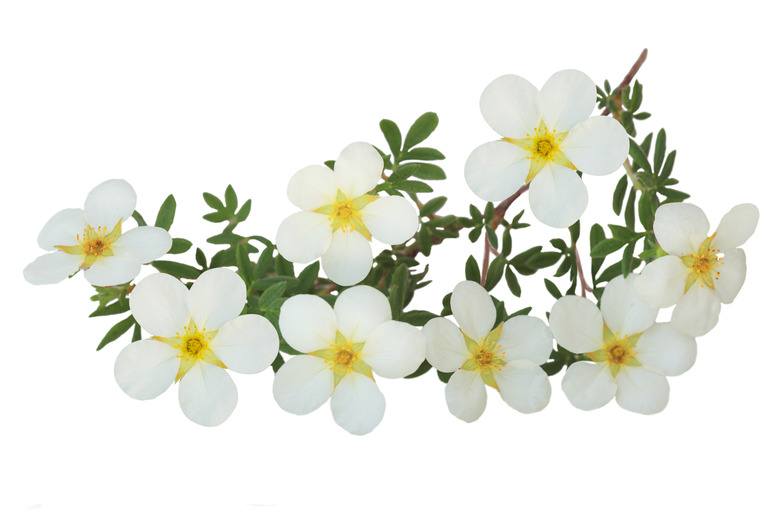How To Prune Potentilla Shrubs
Things Needed
- Hand pruners
- Household bleach
Tip
If your potentilla has become so overgrown that standard pruning won't help, rejuvenate the plant in early spring by cutting all its canes back as close to the soil surface as possible. Use a lawn mower, if necessary. When the new canes appear, thin and shape them as you like.
Warning
Shearing potentilla hedges removes their growing tips, but leaves the old canes in place. Old canes are more susceptible to disease and insect damage than vigorous new ones, so removing them completely via thinning is always preferable to shearing the hedge.
Combine a cold-winter, cool-summer climate, a sunny garden spot and well-drained soil, and you have the ideal environment for growing happy potentilla shrubs (Potentilla fruticosa), also called shrubby cinquefoil or bush cinquefoil. In U.S. Department of Agriculture plant hardiness zones 3 through 7, potentillas re-emerge every spring with upright canes of finely textured, gray- to deep-green foliage. Their five-petaled, roselike flowers — in white and a host of warm colors — provide a spring-to-fall show. Use potentillas as shrub border accents or train several into a head-turning low hedge. Prune the easy-care plants as needed to control their shape and size.
Spring Pruning
Step 1
Start pruning your potentilla shrubs for structure in their third year after planting. Prune them early in spring before their new canes emerge and while their old ones are easily accessible. The goal is to establish and maintain a dense-but-tidy framework that requires a minimum of upkeep.
Step 2
Rinse sharp, clean pruning tools between cuts in a solution of 1 part household bleach to 9 parts water to avoid accidentally spreading disease. Hand pruners are usually adequate to the task of pruning potentillas.
Step 3
Cut your shrub's three thickest canes back to ground level. This lets more air and light reach the interior, stimulating flower production and decreasing the risk of disease.
Step 4
Continue pruning canes to the ground, stopping as you go to look at your work. The goal is to create a natural, informal shape. Prune broken or diseased canes next. Save the healthy ones for last and stop when you've pruned about one-third of the shrub's total canes. Double-check your work and remove any straggly or awkwardly placed twigs.
Step 5
Prune your established potentilla's framework as needed every spring. This technique applies to both single and hedge plants.
Protective Pruning
Step 1
Examine your potentillas frequently for dead, diseased or broken canes. Remove them immediately to protect the plants from invading insects or more infections.
Step 2
Scrape diseased canes with your pruning tool. If you see brown tissue, that part of the cane is dead and should be removed. Keep scraping until you find green tissue. Cut back to healthy wood 6 inches below that point. Make cuts slanting away from and right above healthy leaf buds. If the entire cane is brown, cut it to the ground. Disinfect your pruning tool between test scrapes and pruning cuts.
Step 3
Prune crossing potentilla twigs when the plants stop flowering in fall. Cut one of the branches right above a healthy bud and far enough back that it no longer touches the other one.
